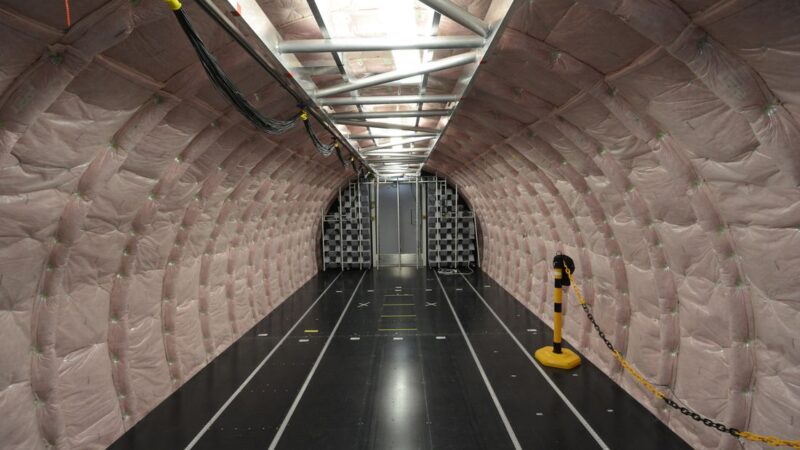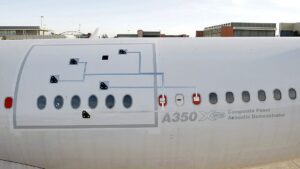Noise reduction, good news for private jets
Noise reduction in the cabin is also very important for private jets, since the smaller the plane, the more noise. It’s no coincidence that the quietest aircraft in the world is the Airbus A380. Indeed, with each doubling of the weight of an aircraft, the sound insulation increases by six decibels. Therefore, the progress that Airbus is making in this area will also benefit private jets.
The Center for Applied Aviation Research (ZAL) in Hamburg has one of the largest acoustic laboratories in Europe. Airbus is investigating how cabin noise can be reduced.
Henning Scheel presses the start button of the program on his computer. Hundreds of speakers sound like a bass guitar, deep, penetrating, but higher frequencies are also mixed in. “That roughly corresponds to the noise level of the counter rotating open rotor,” says Scheel. He is the head of Airbus’ Acoustic Flight Lab at the ZAL TechCenter in Hamburg. A free-swinging cabin demonstrator with the diameter of an Airbus A320 fuselage is used to research how noise and vibrations spread in the aircraft structure and how to deal with them. “It’s not just about reducing noise, it’s also about how to make sounds sound better,” says Scheel.

Noise like on the highway
Aviation is still a long way from the sophisticated sound design of the car industry, where the sound of every door knock is influenced. Nevertheless, Airbus has been dealing with cabin acoustics for decades. “For us, this is a unique selling point that we want to push ahead with,” says Scheel. The focus of cabin acoustics research is in Hamburg, where around 30 employees are involved in the topic. In addition to the acoustics laboratory at ZAL, whose exclusive tenant is Airbus until 2021, the aircraft manufacturer has its own acoustics center in the factory next door in Finkenwerder. No wonder that the quietest aircraft cabin currently is that of the A380. That’s not what Airbus says, but Dr. Kay Kochan from the Center of Competence Cabin & Systems at ZAL: “In acoustics, the so-called mass law of airborne sound insulation applies – it means that airborne sound insulation increases by six decibels per doubling of mass.”
Main sources of noise
In addition to the engines, the main sources of noise in the cabin are the undercarriage, the high-lift systems, the noise around the fuselage, but also the air conditioning and the hydraulic system. “The cabin noise is a broadband noise with tonal components. The maximum of the A-weighted spectrum is around 400 to 1000 Hertz and depends on the aircraft, flight status and the location in the cabin,” says Dr. Kochan. The places that passengers find the quietest are those in front of the wings, far from galley and toilets. And even the weather has an impact on how loud it is in the cabin: a ten degree temperature difference corresponds to about one to two decibels – the warmer the quieter. On average, the noise level of today’s cabins when cruising is between 75 and 80 dB (A). This is comparable to the noise of a busy highway.
Different approaches
There are different approaches to influencing the cabin acoustics. On the one hand, work is being done on the noise sources themselves, i.e. on engines and other systems. For example, modern turbofans are quieter than previous generations of drives due to the increasing bypass ratio. On the other hand there is the very complex and expensive implementation of anti-noise concepts. A sound wave is superimposed and eliminated by an opposite sound wave. Bombardier uses such a system for its private jets, which includes microphones, a control system and actuators, for example in the cabin of the Q400 turboprop aircraft. Airbus has also dealt with anti-noise, but costs and benefits are out of all proportion for jets. “With Active Noise Control, we work with other industry partners, as this is currently more of an issue for in-flight entertainment systems or premium seat manufacturers,” says Dr. Kochan.
Focus on new materials
Another option for quieter cabins is structural measures such as sound insulation between the fuselage outer skin and the cabin side wall. So far, thermoacoustic insulation made of glass wool, for example, has been used. So-called acoustic metamaterials are interesting for even better insulation in the future. “These are clever combinations of materials with small resonant structures that can be set to specific frequencies,” explains Dr. Kochan. These metamaterials can consist of foams, plastics, metals, but also natural fibers.
New Acoustic Insulation Meta-Material Technology for Aerospace
Acoustic metamaterials are also the focus of the German-Canadian research project NAIMMTA (New Acoustic Insulation Meta-Material Technology for Aerospace). It is managed by ZAL and the Quebec company Mecanum, which includes Airbus, the insulation material manufacturer Hutchinson, and the Hamburg University of Applied Sciences. As part of the three-year project that has been running since September 2017, new materials are also to be examined in the Acoustic Flight Lab in the ZAL TechCenter.
The number of individually controllable loudspeakers is 444, divided into two systems that can be moved on a rail around the fuselage. At the same time, a microphone system drives through the cabin that maps the noise. The empty, 8.5 meter long tube can be completely equipped with seats, galley and side panels.
ZAL TechCenter in Hamburg
ZAL was founded in 2009 as a public-private partnership to consolidate Hamburg’s position as the third most important civil aviation location after Seattle and Toulouse. The largest of the nine shareholders, each with a share of 20 percent, are the Hanseatic City of Hamburg, Airbus and Lufthansa Technik. The ZAL Friends’ Association, which brings together industrial associations and aerospace suppliers, holds 18 percent. The German Aerospace Center (DLR) has a ten percent stake, the four Hamburg universities each have a three percent stake.
The ZAL TechCenter opened in Hamburg-Finkenwerder in early 2016. It offers 600 workplaces as well as laboratories and hangars on more than 26,000 square meters of usable space. In the ZAL TechCenter, established companies, startups and universities should work together on innovations and bring new products to market more quickly.

